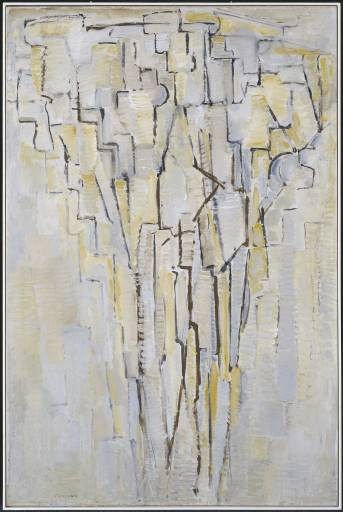Piet Mondrian and Gego
03 Jul 2013 - 19 May 2014
Introducing the Structure and Clarity wing, this room brings together two artists to explore their contrasting approaches to geometric and organic forms, and the relationship between abstraction and the natural world.
Working in the first half of the twentieth century, Piet Mondrian progressed from making landscape pictures towards rigorous, geometric abstract works. Tree A c.1913 reveals the close relationship between his early abstract forms and the natural world. In his later paintings Mondrian rejected nature altogether. Their black and white geometric grids, with selected planes restricted to primary colours, exemplify an extreme austerity in early modernist abstraction.
Gego (Gertrude Goldschmidt) was influenced by abstract-geometric constructivism, but her investigation of line, motion, space and the role of the spectator led her to develop a more expressive approach. From the mid-1960s onwards, she made wire sculptures in which line is volatile, organic and pliable. Many of her works take the form of webs or nets which are based upon triangles, squares, pentagons or octagons but also disrupt these basic geometric forms. Exhibited in groups or stacked to address the complex interaction of forms and their organisation in space, her sculptures establish a dialogue between the orderly and the chaotic.
Piet Mondrian (1872–1944) was born in Amersfoort in the Netherlands. He lived in the Netherlands, Paris, London and New York.
Gertrude Goldschmidt (1912–1994), known as Gego, was born in Hamburg, Germany. From 1939 she lived and worked in Caracas, Venezuela.
Curated by Tanya Barson
Working in the first half of the twentieth century, Piet Mondrian progressed from making landscape pictures towards rigorous, geometric abstract works. Tree A c.1913 reveals the close relationship between his early abstract forms and the natural world. In his later paintings Mondrian rejected nature altogether. Their black and white geometric grids, with selected planes restricted to primary colours, exemplify an extreme austerity in early modernist abstraction.
Gego (Gertrude Goldschmidt) was influenced by abstract-geometric constructivism, but her investigation of line, motion, space and the role of the spectator led her to develop a more expressive approach. From the mid-1960s onwards, she made wire sculptures in which line is volatile, organic and pliable. Many of her works take the form of webs or nets which are based upon triangles, squares, pentagons or octagons but also disrupt these basic geometric forms. Exhibited in groups or stacked to address the complex interaction of forms and their organisation in space, her sculptures establish a dialogue between the orderly and the chaotic.
Piet Mondrian (1872–1944) was born in Amersfoort in the Netherlands. He lived in the Netherlands, Paris, London and New York.
Gertrude Goldschmidt (1912–1994), known as Gego, was born in Hamburg, Germany. From 1939 she lived and worked in Caracas, Venezuela.
Curated by Tanya Barson

